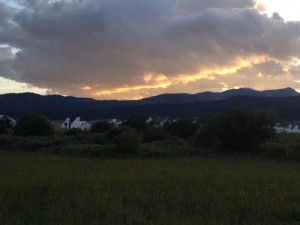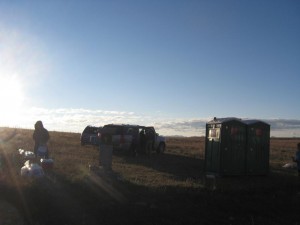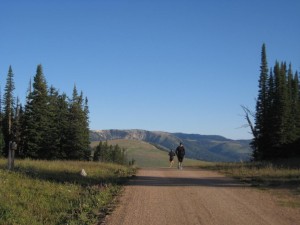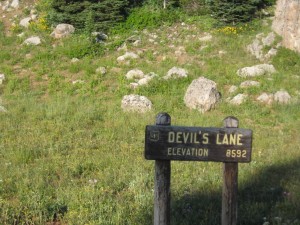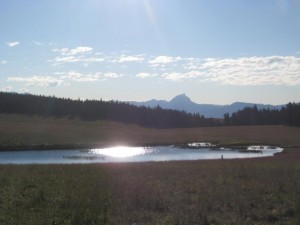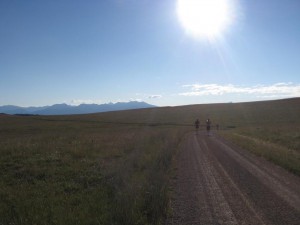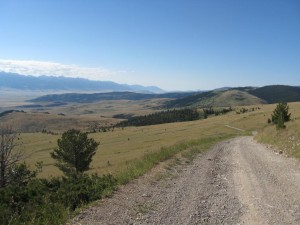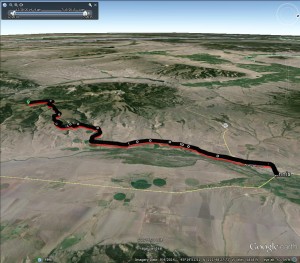A few months ago, I made the decision to search out a fun marathon, requiring some traveling, to compete in during the month of July. One of the challenges of marathoning is that I have most of my “free time” in the summers, but for much of the United States, the summer months tend to be on the hot side for long races. One of the exceptions to this is our own regional Mad Marathon, held in Waitsfield, VT in early July, but I had already run that particular race a few years ago. While running this race, I was introduced to the world of the “50 States Marathon Club” whose members seemed to have a heavy presence in this local race for just that reason. So, I googled for “July Marathons” and found one that piqued my interest – the inaugural “Big Sky Marathon” in Ennis, Montana, on July 19, 2015.
The Big Sky Marathon is the younger sibling of the already established Madison Marathon, one of the toughest “road” marathons in the US, due to its challenging terrain and high altitude. Sam, the race organizer, clearly a glutton for punishment, decided to follow up his established Madison Marathon with the Big Sky Marathon, on the very next day. Wow. The big difference between the two races is that the Madison Marathon starts and finishes at altitudes which might prove unrealistic for many runners recently arrived from lower altitudes, especially in light of its many climbs and descents, while the Big Sky Marathon, not lacking in its own challenges, is more “altitude friendly”, descending from high altitude (8500 ‘) to the valley floor at a much more reasonable altitude (5000′) over its duration, without any significant climbs. I did not for a minute think that this race would be easy – but I can train for descents, not for altitude!
Reading through the web site for these races, it was apparent that Sam wanted a race which would appeal to two groups of runners – the aspiring 50-Staters, who might find the new marathon’s altitude profile less intimidating than the Madison, and a group which I had never heard of before, the “Marathon Maniacs“, a running group which honors runners who complete large numbers of marathons in a short period of time, and who are particularly keen on running marathons on back-to-back days. Ouch. I counted myself among the former, not the latter.
So, looking forward to the upcoming adventure, I flew into Montana, rented a car, and spent two nights sleeping in a canvas tipi (hey – it was cheap!) in West Yellowstone, MT, acclimating, and enjoying Yellowstone for two days before the race.
Given that the race was mostly downhill, and I have had a lot of experience at altitude, I knew I could handle the “breathless” component of the moderately high altitudes where I would be running – Past experiences told me that I just had to never run hard enough that I was seriously out of breath (aka- no “going anaerobic”), which I wouldn’t do in a marathon anyways. I was more concerned with hydration issues. Most tourists don’t notice high altitude dehydration, as the most common repercussion, especially in the dry, sunny climate of the Rockies in the summer, is that they get tipsy a little faster at cocktail hour. Bearing in mind that I was running a marathon in two days, I was constantly drinking water as soon as I arrived, but it seemed like I was losing more than I was taking in. There were other issues with this that arose during the race.
The town of Ennis, which serves as the headquarters for these races and as the finish line for the Big Sky Marathon is a cute little town about an hour northwest of West Yellowstone, located in the Madison River valley (apparently home to some of the best fly fishing in the country) between the Madison Mts. to the East (the range just to the west of Yellowstone Park, and home of the Big Sky Ski Area) and the Gravelly Mts to the west, where the race was held. Ennis reminded me a lot of Jackson, WY in the 70’s before it got turned into a tourist trap and became surrounded by the summer homes of billionaires and Hollywood types. It has a tiny little village with small shops, bars, and cafes, plenty of shade, and is a fringed by the less quaint sort of places where probably many of its inhabitants are actually employed. I pulled into Ennis at 5 am on the morning of the race, and met up with the race organizers and other competitors at a gas station in town, where I realized how intimate a race I had gotten myself into. Almost all the competitors took the school bus to the start line, and there couldn’t have been much more than 40 of us, and a few were doing the half marathon version rather than the full!
The bus ride to the start was the first adventure of the day, and followed the course of the race in reverse. Looking around the people on the bus, it seemed like there were some real hard core runners, male and female, who looked the part that I expected for a race like this. The other half, well they looked like me – fit marathon tourists, not necessarily that young in chronology while clearly young at heart. This was the peer group I expected to find myself running with. After the drive along the valley floor, the bus turned off and started to weave its way up the east flanks of the Gravelly Mts on rapidly deteriorating dirt roads, with pronghorn antelope scattering as the big yellow monstrosity approached. At one particular point I remember noting a steep primitive road angling up the mountainside, and thinking “a school bus can’t make up that, can it?” And it did!
Finally after about an hour on the school bus, it screeched to a halt high at the starting point high on a mountain ridge, not too far from a few small snow banks, and the well-hydrated runners dashed out to relieve themselves, either in one of the two porta-potties brought to the start for the race (courtesy dictates that women, of course, get first dibs on these) or on the above timberline wildflowers (for the men, out of necessity).
At 7:30 in the morning, after Sam sketched a start line in the dirt road, the race started with a short half mile climb up to the high point in the race. Many of the runners started off very conservatively, walking this first ascent in light of the altitude, while others took off like they were shot from a cannon. I started off this climb at a slow 10 minute mile pace, which pretty much put me in the middle of the pack as the participants spread themselves out almost immediately.
The scenery at this point was simply spectacular – Over the course of the first 10K of the race, the descents were pretty mellow, and we were running through wide-open alpine meadows and cattle grazing fields, where I could see the mountains of Montana in all directions, and other racers strung out thinly in front of me. There seemed to be a lot of them in front of me!
The second 10K was the part that race guru Sam referred to as “the quad burner” section, where most of the 3500 ft descent transpired. I usually feel steep descents in my glutes (butt!) more than my quads by the way. This was an interesting part of the course, but knew would be one of my stronger sections given my Vermont trail running background.
At one point, I seemed to have set off a small stampede of the grazing Black Angus cattle grazing on the slopes of the mountains, but I suppose they weren’t running at me – they were probably running from whatever was chasing me! I also noticed that without pushing things particularly hard, I started passing some people who had long been far in front of me – perhaps all the running in the Vermont trails was paying off? I was clearly moving up through the pack, but I truly had no idea of “where I stood” in the race standings, given how spread out the runners were. At the 13 mile point, at the end of the serious descent, a few of the runners in front of me called it day as half marathon competitors, and the second flat, easier part of the race through ranch land alongside the Madison River began. Flat is easier, right?
It wasn’t. Why? HYDRATION! While I felt well hydrated before the start, during the first half of the marathon, in the cool morning weather, descending, I drank water at about the same rate I would during a sea level marathon – a few ounces of water or Gatorade every two to three miles works just fine for me usually. By the time I reached the valley floor, unbeknownst to me, I was starting to get seriously dehydrated. I usually do my fastest running in the middle 1/3 of marathons, and while I did pick up the pace for a few miles to pass a few more competitors, by the time I reached the water station at mile 17 I could tell that I was in trouble. I had to stop for a few minutes, and drink about a liter of water. The water lost through normal running at the early altitudes, and the relentless sun (there isn’t much shade in this part of Montana- they don’t call it “Big Sky Country” for nothing!) in the cool temperatures had baked a lot of water out of me! From this point until the end of the race I needed to drink about two more liters of water from the water stations, and walked far more frequently than I have ever done in a marathon in order to recover from the dehydration, as well as the descent which had taken a toll on my legs. I ended up leapfrogging with another strong runner at this point, a gentleman somewhat younger than I for whom this was his hundredth marathon, before eventually pulling away a few miles from the finish line. I was totally relieved to see the “Welcome to Ennis” sign a mile from the finish line, fighting leg and foot cramps, but determined to run the last mile without stopping.
Since this was such a small race, normal, but mellow traffic continued without any roads blocked off, so I brought it in to the finish line in a small park at the far side of the village, running on the sidewalks with encouragement from the few people who knew that there was a race finishing in their town. The finish line was simple – a few orange traffic cones, and a few volunteers with a stopwatch. My time made it my slowest marathon in a few years by about twenty minutes, which at first disappointed me. As I gathered my wits at the finish line I looked around, expecting to see the runners who had finished already sprawled all over the lawn, but the only folks I saw were Sam, and a few volunteers. I inquired as to my finish, suspecting that I had managed to sneak my way into the top ten, when I heard the shocker “2nd PLACE!” How on earth did that happen? I realized that I had passed more people than I first suspected, a few had dropped out at the half marathon point, and most importantly, a lot of the best runners were attempting to complete two marathons in two days, and thus were running at a far slower pace. Never having finished this high in a race, I sought out the winner to offer my congratulations – that is what you are supposed to do right? This was new territory for me. Apparently he had beaten me by an hour, and had to take his medal and driven home to Arizona to get to work the next day. He had also run in the previous day’s race. WOW! Well done, whoever you are! So instead, I hung out for the next 45 minutes or so as other racers trickled in, cheering them on as best as I could. Alas, I did not have the chance to meet the race’s celebrity, an older fellow who apparently was using this race to complete his 1500th marathon. now THAT is a marathon maniac! In another interesting twist, since I was wearing a Middlebury College t-shirt, a gentleman came up to me and identified himself as a Middlebury College graduate, and he was there waiting for his wife to finish. It’s a small world sometimes.
All in all, this was a memorable race for all the right reasons. It had a unique twist, and was really a well inspired, organized, and from my perspective, well executed race by Sam the organizer. He was in perpetual motion over the course of the day – moving from water station to water station, and cheering on the racers along the way. He reminded me a lot of my favorite race organizers in Vermont, people who work hard out of their love of the sport and competition, and want to offer participants the opportunity for a uniquely memorable experience, while keeping their sense of humor. I am glad that races like this can still be found, even as running becomes more and more corporate. Well-done! And did I mention that this is about as beautiful as it gets for running scenery?
The only drawback? My reward for the runner-up finish was a shot glass and a few tokens for free beers in the town’s brewpub, and I still had a half day drive in front of me to get back to Billings to catch my plane home the next day. Someday……
